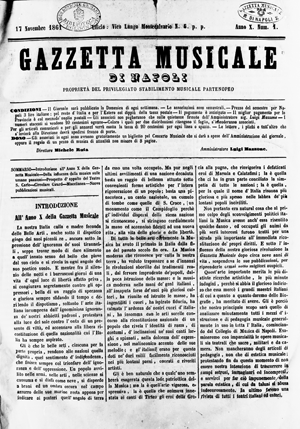Gazzetta musicale di Napoli
Prepared by Elvidio Surian
Online only (2016)

The Gazzetta musicale di Napoli [GMN] was published in Naples from July 1852 to December 1868. Printed throughout in a three-column format, it was published in weekly installments from 1852 to 1864, and bimonthly issues from 1865 to 1868. Each weekly issue consists from four to eight pages. The pages of individual years are numbered continuously from 1852 to 1864, while each issue is numbered independently from 1865 to 1868. GMN was suspended after July 12, 1860 owing to political turmoil in southern Italy against the ruling Bourbons. It resumed publication on 17 November 1861, after the Kingdom of Italy was formally established. The journal is a leading primary source of information on musical life in mid-nineteenth-century Naples.
GMN was printed throughout by the Stabilimento Musicale Partenopeo, a firm which controlled the entire music market in Naples between 1850 and 1860, publishing the majority of new works by Neapolitan composers. The firm was taken over by the Ricordi publishing firm in 1884. Its owner-director Teodoro Cottrau (1827-1879), was a poet and musician composer of Neapolitan popular melodies (for example “Santa Lucia”). Cottrau served as editor of the journal from 1852 to 1860. During its sixteen years of publication GMN had four other editors: Pasquale Trisolini (1827-1870), editor-in-chief from 1852 to 1859; Ferdinando Taglioni (1810-1874), editor from 1856 to 1859; Michele Ruta (1826-1896), editor from November 1861 until January 1862; and Luigi Mazzone (1820-1897) editor-in-chief from 1859 to 1868. Trisolini, Ruta and Mazzone were all strong defenders of the Italian music tradition, tied to opera and to the art of singing. In fact, GMN focuses its attention on theatrical works of new and successful composers such as Petrella, Mercadante and Verdi. Taglioni was responsible for reviews of the city’s most important musical events, and for articles dealing with music criticism and music history He also organized (March-April 1856) the first historical concerts in Naples, and founded with Cottrau a theatrical agency in 1856.
Following the opening essay dedicated to topics of historical interest, music theory and pedagogy, each issue regularly comprises a series of sections that report on musical activities, in the main operatic, but dealing as well with sacred music that was performed in Neapolitan churches and concerts that took place in private homes. Reports from other Italian cities and major European music capitals are also given. The reviews and notices of musical events outside of Naples are frequently drawn from articles that appeared in other Italian and, less frequently, foreign journals.
Of particular interest is the section entitled “Cronaca del Regno” [Chronicle of the kingdom] that documents, from 1854 to 1858, the musical activities of peripheral provincial cities of the Kingdom of the Two Sicilies. After 1860 GMN reserves more space for essays that deal with the reform of music instruction in Naples, copyright protection, and the establishment of a diapason normal. Most noteworthy are the reports on the activities of the Circolo Musicale Bonamici, an association founded by composer and pianist Ferdinando Bonamici (1827-1905) with the intent of raising the level of Italian musical culture by organizing conferences and regular concerts of instrumental music of both Italian composers and the creators of the Viennese classics. The Circolo Musicale also undertook the ambitious project of organizing the First Italian Music Congress in Naples in September and October, 1864. GMN publishes the minutes of the Congress and reports of the activities of the Circolo from 1863 to 1867. The closing pages of some issues contain a list of the current publications of the Stabilimento Musicale Partenopeo.
